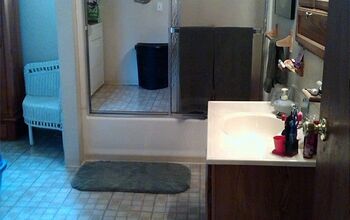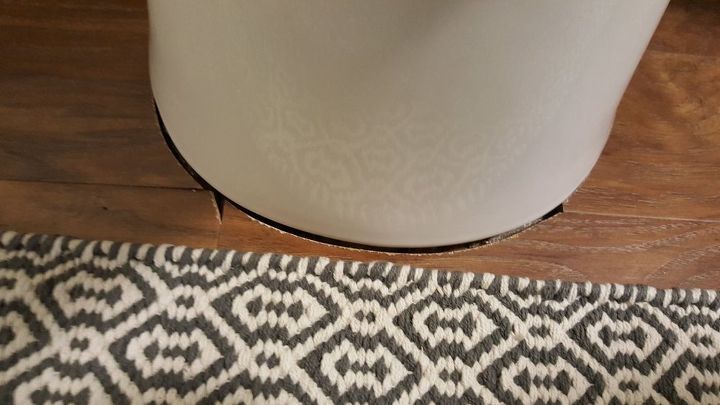New peal and stick tiles coming up. Help!

-
The issue may not be with the tiles but the material that is below them. Moisture can play havoc with many products with swelling and shrinking. It appears that this may be the cause of the issue. The primer is used to give the tile adhesion to the base the tiles are set upon If moisture or water has leaked through the edges of the peel and stick tiles this moisture most likely has allowed the floor to swell thus causing the adhesion failure. The ideal fix is to remove these offending tiles repair any damage and start over. However if your able to push the tiles back down and they simply do not stick. A fast acting epoxy may do the trick. A very tiny dab should do the trick. To keep the moisture out, wax the floor well between the tiles to help keep the moisture out. Another method is to use a vinyl seam repair kit. This product is applied with a small syringe where a chemical is applied that melts the vinyl ever so slightly and glues the two jointed tiles together. They use this product with roll type vinyl flooring. If its done right and carefully the grout line in the vinyl tile will blend with the other and you will never see it.
 Woodbridge Environmental Tiptophouse.com
on Mar 14, 2014
Helpful Reply
Woodbridge Environmental Tiptophouse.com
on Mar 14, 2014
Helpful Reply -
-
Yes I agree with approaches mentioned above. We've tried them with mixed results. If those don't give a satisfactory result, and you feel a do over is necessary, we've gotten great results by using a hard underlayment, like luan primed with high-build polyurethane. It really gives the tile something hard and smooth to stick to and it resisted moisture better than the typical primers. Good luck.
Southern Home Improvement, LLC on Mar 14, 2014
Helpful Reply -
-
The trick to Robert Johnson's floor is that he used the poly seal on the luan. Many floors are ruined using luan plywood for underlayment if there is any chance that moisture can reach it. From below or from leaks over top. This material swells greatly and many a good floor has been destroyed and required complete removal and repair when it was used.
 Woodbridge Environmental Tiptophouse.com
on Mar 14, 2014
Helpful Reply
Woodbridge Environmental Tiptophouse.com
on Mar 14, 2014
Helpful Reply -
-
@Woodbridge has a good point, and thanks for bringing it up. Sometimes I assume everyone knows the obvious. And after 30 years of success I prefer to look at it as skill rather than a trick. lol But semantics aside, before installing this type of system we are always reasonably sure the subfloor or existing floor provides adequate protection from moisture infiltration from below. Then we thoroughly coat the luan, like we were sealing a hardwood floor, so that is completely sealed and smooth. The most important thing to remember is that peel and stick tiles and the components that are often used to make up that type of flooring system are very susceptible to heat, cold, and moisture and therefore are not as easy to install in a DIY application as the commercials suggest.
Southern Home Improvement, LLC on Mar 15, 2014
Helpful Reply -
-
I'm going to the hardware store today to find the seam repair kit. It isn't moisture that's causing the problem, I'm the only one living in my home and I even hang my bath mat when I get out of the shower. Thank you for your help..
 Kathy Larsen
on Mar 21, 2014
Kathy Larsen
on Mar 21, 2014
 Helpful Reply
Helpful Reply -
-
Moisture can be coming from many sources that your not aware off. Higher humidity in the room when taking a shower can do it, moisture from the room or basement below can cause this. Simply washing the floor is enough. But check out the seam sealer. It cannot make it any worse.
 Woodbridge Environmental Tiptophouse.com
on Mar 21, 2014
Helpful Reply
Woodbridge Environmental Tiptophouse.com
on Mar 21, 2014
Helpful Reply -
Related Discussions
How to get rid of mice?
We seem to have some unwelcome Mickeys and Minnies in our house. What is the best way to get rid of them?
How to remove popcorn ceiling with asbestos?
I want to remove my popcorn ceiling, but it has asbestos in it. How do I go about this safely?
How to caulk baseboard gaps?
How do I fill gaps at baseboard, should I caulk? If so, does anyone know how to caulk baseboards?
How to fix squeaky hardwood floors?
How do I fix squeaky hardwood floors?
Tile backsplash when there is existing countertop backsplash
We are thinking about how to add a backsplash to our kitchen. Unfortunately when we had our countertops installed we ordered a small backsplash that comes part way up... See more
Contractor mis-cut the floor when he put in the toilet
Hello, Our contractor didn't "measure twice, cut once" when he put in our toilet. Check out the photo. I'd appreciate any suggestions on a fix or a way to hide this m... See more





